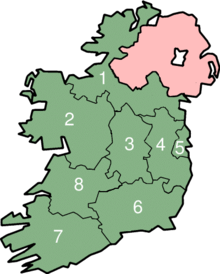Regional Authorities in Ireland

1. Border Regional Authority
2. West Regional Authority
3. Midlands Regional Authority
4. Mid-East Regional Authority
5. Dublin Regional Authority
6. South-East Regional Authority
7. South-West Regional Authority
8. Mid-West Regional Authority
Regional Authorities in Ireland were established by the Local Government Act 1991 and came into existence in 1994. Under this Act, the Regional Authorities had two main functions: to promote the co-ordination of public service provision and to monitor the delivery of European Union Structural Fund assistance in the regions. The Regional Authorities were dissolved in 2014 and were replaced by Regional Assemblies.[1]
Membership
The members of the Regional Authorities were not directly elected, but were nominated from among the elected members of the local authorities in the region. Each local authority had a certain number of seats on a Regional Authority, based loosely on the population of the local authority area. The size of the Regional Authorities varied from 21 members in the Mid-East region to 37 members in the Border region.
Structures
To assist the Regional Authority in undertaking its functions, each has an Operational Committee and an EU Operational Committee. The Operational Committee is chaired by the Cathaoirleach (Chairperson) of the Regional Authority and is composed of senior management from the constituent local authorities and other relevant public sector agencies operating in the region. It helps prepare the work of the Regional Authority and assists and advises it on matters relating to its functions. Also, each Regional Authority has a designated city/county manager (chief executive of a local authority) from one of its local authorities to further enhance the linkages between the local authorities and the Regional Authority.
The EU Operational Committee has a similar, but broader, composition and assists the Regional Authority in matters relating to EU assistance and reviewing the implementation of various EU Operational Programmes in a region.
Each Regional Authority has a Director, assisted by a number of policy and administrative staff. They are NUTS III level.
The Regional Authorities had specific responsibility for:
- Reviewing the Development Plans of local authorities in their region and in adjoining regions;
- Preparing Regional Planning Guidelines and Regional Economic and Social Strategies;
- Promoting cooperation, joint actions, arrangements and consultation among local authorities and other public bodies.
Financing
The financing of the activities of the Regional Authorities was largely borne by their constituent local authorities.
Former Regional Authorities at NUTS 3 level
- Border Regional Authority (Comprised the areas under the jurisdiction of County Cavan, County Donegal, County Leitrim, County Louth, County Monaghan and County Sligo)
- Dublin Regional Authority (Comprised the areas under the jurisdiction of Dublin City Council, Dún Laoghaire–Rathdown, Fingal and South Dublin)
- Mid-East Regional Authority (Comprised the areas under the jurisdiction of County Kildare, County Meath and County Wicklow)
- Midlands Regional Authority (Comprised the areas under the jurisdiction of County Laois, County Longford, County Offaly and County Westmeath)
- Mid-West Regional Authority (Comprised the areas under the jurisdiction of County Clare, County Limerick, Limerick City Council and North Tipperary)
- South-East Regional Authority (Comprised the areas under the jurisdiction of County Carlow, County Kilkenny, County Waterford, County Wexford, South Tipperary and Waterford City Council)
- South-West Regional Authority (Comprised the areas under the jurisdiction of Cork City Council, County Cork and County Kerry)
- West Regional Authority (Comprised the areas under the jurisdiction of County Galway, County Mayo, County Roscommon and Galway City Council)
2014 reforms
The legislation which abolished the eight regional authorities and two Regional Assemblies and which also replaced them with three regional assemblies was the Local Government Act 1991, particularly the statutory instrument number 573/2014 of 2014.[2][3] The Order provided for the transfer of staff, assets, and liabilities to the successor assemblies. It described the area under the remit of the regional authorities:[4]
- Eastern and Midland Regional Assembly – which comprises the combined territory of the counties of Dún Laoghaire–Rathdown, Fingal, Kildare, Laois, Longford, Louth, Meath, Offaly, South Dublin, Westmeath and Wicklow as well as the territory of the city of Dublin.
- Northern and Western Regional Assembly – which comprises the combined territory of the counties of Cavan, Donegal, Leitrim, Galway, Mayo, Monaghan, Roscommon and Sligo as well as the territory of the city of Galway.
- Southern Regional Assembly – which comprises the combined territory of the counties of Carlow, Clare, Cork, Kerry, Kilkenny, Limerick, Tipperary, Waterford and Wexford as well as the territory of the cities of Cork and Waterford.
References
- ↑ http://www.irishstatutebook.ie/2014/en/si/0228.html
- ↑ PART 2 REGIONAL ASSEMBLY AREAS, ESTABLISHMENT, CONSTITUTION, MEMBERSHIP AND RELATED PROVISIONS - " 4. (1) Each area described in column (2) of Schedule 1 shall constitute a region within the meaning of and for the purposes of section 43 of the Act of 1991, and shall be called and known by the name specified in column (1) of that Schedule opposite the description of that area."
- ↑ "Putting People First" (PDF). Department of the Environment, Community and Local Government. October 2012. Retrieved 16 October 2012.
- ↑ http://www.citizensinformation.ie/en/government_in_ireland/local_and_regional_government/regional_assemblies.html
External links
- Official website Eastern and Midland Regional Assembly
- Official website Northern & Western Regional Assembly
- Official website Southern Regional Assembly